Intel Confirms Some Details about 28-Core 5 GHz Demonstration
by Ian Cutress on June 8, 2018 12:45 AM EST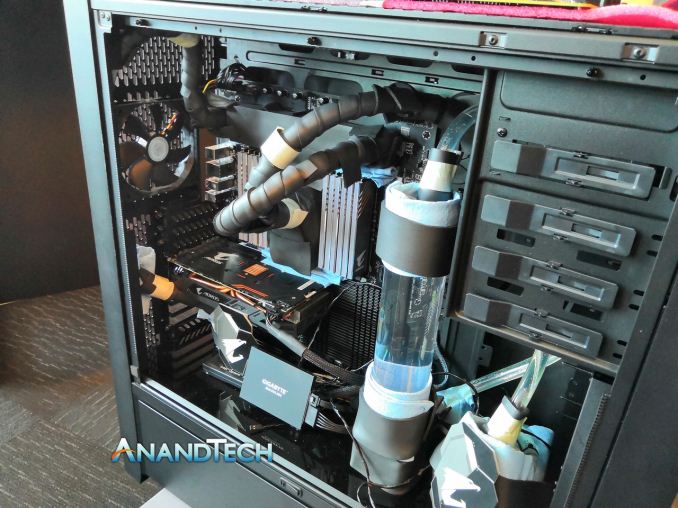
When Intel demonstrated its 28-core system running at 5 GHz at the Computex 2018 keynote this week, there were many questions surrounding the hardware and what was required in order to showcase this. The presentation was relatively light on details – perhaps purposefully so – however Intel SVP and GM Gregory Bryant stated that the processor was set to come out during Q4.
You can read our coverage about the launch in this article:
Intel's 28-Core 5 GHz CPU: Coming in Q4: Link
We also had a chance to examine the system that the demo was run on, in particular the cooling method and the motherboard. We have this article here:
We Got A Sneak Peek on Intel's 28-Core: All You Need to Know: Link
Now there were obviously a lot of questions about the demonstration. Was the CPU overclocked? What cooling was used? What platform did it run on? Which motherboard did it run on? What architecture is being used? What process node? What was the power consumption? We met with an Intel representative yesterday who answered some of these questions.
Was the CPU Overclocked?
The Intel representative did confirm the CPU was overclocked. We were told that on stage the presenter was actually meant to clarify that the system was overclocked, however the specific wording was not stated as it had been prepared.
There are many ways to interpret this – we did tell Intel that we had hoped that the presenter would have spent more time on stage talking about the system in play, discussing the platform it was running on, and making the system more ‘bright’ inside so that people could determine several things from photographs, rather than it looking almost like a black box with hidden pipes. Our commentary was taken on board by the Intel team we spoke to.
What cooling was used?
Intel confirmed that a water chiller was used, which we saw in our system demo examination the day after the presentation. We were told that it was not intended to showcase the cooling on the stage due to time constraints, to which we responded that Intel’s implementation of pre-overclocked systems in the past are typically accompainied a discussion on the pre-overclocked nature and the cooling used in the past, yet this presentation did not have this.
In our pre-briefing it was stated that this was a technical showcase (the bit where it was stated that this was coming to market was a bit of a shock if we’re honest), however this was not communicated as well as it should have been on stage. Again, Intel stated that they were taking our comments on board.
What Platform Did It Run On?
Intel did not answer this platform directly, however it was clear that the CPU was aimed at the LGA3647 server-based socket given from our examination of the demo system. It was unclear how Intel was going to promote this as an extreme workstation-type system, however Intel did note that they expect only a select market to be interested in this type of processor: a niche of a niche.
Intel know very well that there is a crowd of its customers that will buy performance at any price, and it doesn’t take a leap to suggest that this part is for those users.
Which Motherboard Did It Run On?
At the time of the presentation, Intel stated that they had partnered with both ASUS and GIGABYTE to create systems around the new 28-core product, however they didn’t state which system the 5 GHz demo was run on. We heard from both of the motherboard companies that it was actually the GIGABYTE system that hit 5 GHz, however it was noted that Intel did not explicitly call out the partner that hit the milestone. GIGABYTE confirmed that they certainly hit 5 GHz; we have yet to speak to ASUS on the matter. We do know that Intel quickly removed the CPUs in the demo systems from ASUS and GIGABYTE the next day with little notice. In between those times we have seen videos published from LinusTechTips (on ASUS) and Paul’s Hardware (on GIGABYTE) showing a Cinebench run.
What Architecture Did It Run? What Process Node?
The only item that Intel would confirm here is that the 28-core processor is built on one of its 14nm nodes. For anyone thinking it was a 10nm node, this confirms that it was not, however it does not say much more; Intel is purposefully keeping its cards close to its chest on this one. The smart money seems to be that the chip is likely to at least be based on the Skylake-X processors, like the 28-core Xeon Platinum 8176 or Xeon Platinum 8180, rather than the future Cascade Lake platform, however Intel has also promised that the consumer version of Cascade Lake-X will be coming by the end of the year.
Speaking with the motherboard vendors and OEMs in general about Intel’s HEDT plans is a tricky business, but most seem to be focused on their current X299 motherboards right now rather than a series of X299 refreshes that normally accompany an HEDT update.
What was the Power Consumption?
Again, this was one of the items that Intel wants to keep close to its chest. After confirming that the 5.0 GHz number was an overclocked value, it does mean that the base TDP for a ‘retail’ processor will be much lower, as the chip will be running at much lower clocks. The Xeon Platinum 8180 has a base frequency of 2.5 GHz and a turbo of 3.8 GHz for a TDP of 205W (TDP being defined at the base frequency only), and we know that the LGA3647 socket by its Intel reference design was made for chips up to 265W, so the frequency of the 28-core part shown by Intel for extreme workstations is only likely to be a +100-400 MHz more at most.
Interestingly enough, Intel states the maximum operating temperature of the 8180 at 205W TDP as 84C case temperature and 98C DTS, which sounds slightly higher than its standard settings for enterprise chips. It would mean that this new 28-core, if it comes out at 265W TDP, is likely to be a super high bin of the part. Of course, this will come with a higher cost.
One of the interesting numbers to come out of the initial announcement were that overclockers were seeing 1000W power draw for an 18-core Core i9-7980XE at 4.9 GHz, so one would assume that a 28-core at 5.0 GHz would be more. We know that the demo that achieved 5.0 GHz was using a Hailea water chiller capable of 1770W of cooling, and the system being used had a 1600W power supply with a low power graphics card. That gives us a good idea for low-bound and high-bound. However Intel would not help narrow down our estimates.
What Intel Needs To Do
One of our points to Intel was that the story around the 28-core announcement was not ideally communicated. (ed: this is an understatement) The systems holding the machines were not very well described in what they were doing, leading to massive amounts of speculation. The insides of the systems were dimly lit, and the cooling apparatus was hidden. Intel could have made the story around the parts be about the technology behind the demonstration, and the ability to push the limits of the hardware to new heights, however, even if the word ‘overclocked’ was accidentally not said on stage, these part of the story was not explained. Not in the ‘it wasn’t explained well’, it just wasn’t explained period. The best thing Intel can do at this point is to grab the story by the horns, and show that this is a passion project: let the readers and reviewers know about the platform, about the implementation (even if new explicit information isn’t shared), and that it actually takes a good amount of engineering prowess and skill to put on a 28-core, 5.0 GHz demonstration.
As it stands, we await further information.
| Want to keep up to date with all of our Computex 2018 Coverage? | ||||||
 Laptops |
 Hardware |
 Chips |
||||
| Follow AnandTech's breaking news here! | ||||||


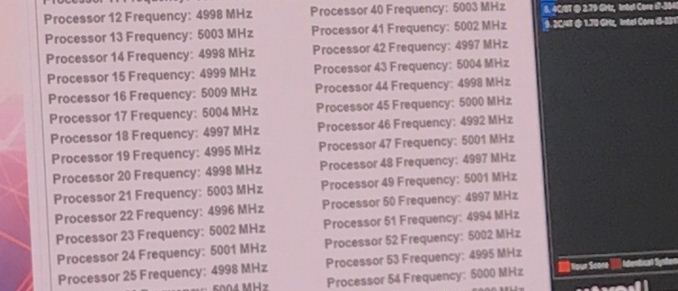
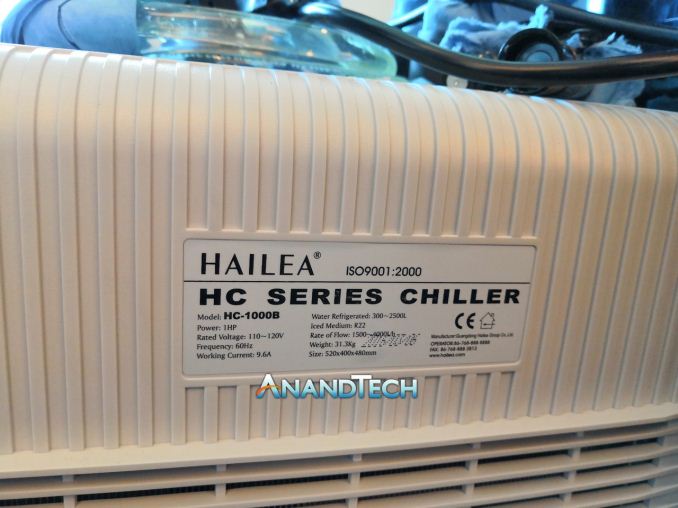
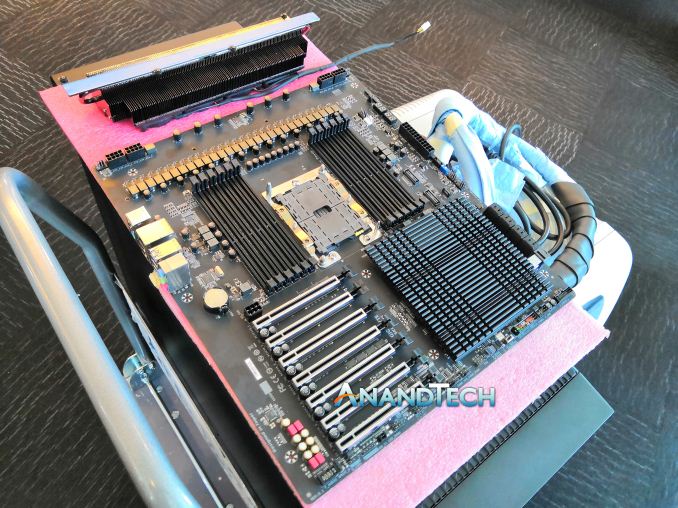
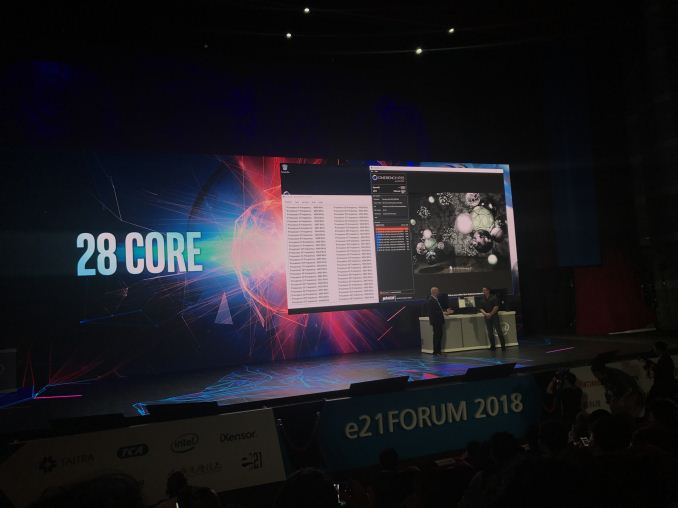








145 Comments
View All Comments
mkaibear - Friday, June 8, 2018 - link
So, this was an epic balls-up by Intel on all accounts.Dunno who thought it would be a good idea to try to obfuscate the chiller and overclocked nature but they should be beaten with a sack full of Prescott heatsinks for even suggesting it.
I mean really.
If Intel had come out and said "look at what our CPUs can do under extreme cooling conditions - 28 cores at 5GHz", the tech world would have gone "wow, that's impractical but cool" (apart from the AMD fanboys who would have thrown popcorn as usual)
Instead they've created a whole poonami of criticism because it looks like they've tried to hide what they've done and claim things they haven't.
What a bunch of idiots!
Manch - Friday, June 8, 2018 - link
<quote>... they should be beaten with a sack full of Prescott heatsinks for even suggesting it.</quote>THIS^^^
Ket_MANIAC - Friday, June 8, 2018 - link
Oh my god, that Prescott heatsink comment was beautiful.eastcoast_pete - Friday, June 8, 2018 - link
+1 , especially on the Prescott heatsink spanking. Instead of engaging in a downright Eagerly awaiting the video of that on youtube.This juvenile "my chip runs at higher GHz than yours" vs. AMD, show some real life upsides. One of them is the ability to run AVX-512 extensions, which results in a huge speed-up of those applications that make use of it. Of course, that wouldn't have been at anywhere near 5 GHz (esp. not on all 28 cores), but would have given Intel something meaningful to crow about.
dynamis31 - Friday, June 8, 2018 - link
Reaction of panicked guys.Read this : https://www.forbes.com/sites/tiriasresearch/2018/0...
It explains quite perfectly why they're acting with such confusion. They were not prepared to zen and AMD execution, may be too focused on nVidia and Arm threats. If Global Foundries accelerates and is able to increase 7 nm production, they will loose huge market share in the coming years, in all CPU fields.
Atari2600 - Friday, June 8, 2018 - link
Ryan/Ian et al,You guys need to become much more cynical and write the stories as such.
If a couple of hours earlier Intel made a big deal about releasing the 8086 that could turbo to 5GHz on one core, how on earth could you conclude that a 28 core machine running 5 GHz on all cores could be anything but a PR stunt?!?
Headline should have been along the lines of: "Intel shows 5GHz on 28 cores - likely a cynical PR stunt"
Sub headings should have been:
"- no details forthcoming"
"- box shrouded in darkness"
"- water pipes coming from box"
"- cooling system unknown"
"- coincidence that AMD are likely to be talking about Threadripper 2 tomorrow?"
Then if Intel have a problem with it - they'll have to back up their argument with facts, figures and details.
As it is, they've played you (along with most of the rest of the tech press) unfortunately.
sonny73n - Friday, June 8, 2018 - link
It would be awesome if AT always tell it like it is. But hey, it’s today journalism at its finest - telling what their sponsors told them to.Ryan Smith - Friday, June 8, 2018 - link
"telling what their sponsors told them to. "I have to admit, these statements irk me. It puts me into a position where I have to prove a negative. That no one - not our publisher, not Intel, not Darth Vader himself - told us what to write.
Everything in this article is Ian's take on the matter as a professional journalists. I have no idea whose ads are running on this article, nor do I care. That is our advertising department's concern, and the departments are compartmentalized specifically for the reasons of editorial integrity. We don't even accept sponsored travel (i.e. every last bit is paid out of our own pockets) so that we can maintain this integrity. That's how important it is to us.
So to insinuate or imply that this article is dishonest and that Ian is writing what he is being told to write is disrespectful to him and all the effort he's put into this and other articles chasing down the facts.
Frankly if we wanted to just write things for other people, we could go get PR jobs and get paid twice as much to do half the work.
RealBeast - Friday, June 8, 2018 - link
Ryan, the whiners will whine.Your articles were fine and you undated them as events unfolded. AT remains a go to site for tech news.
Any complaints should really be aimed solely at Intel for their deception, intended or not (I lean towards intended but perhaps the pressure from above pushed some marketing folks beyond ethical boundaries). Seems to me that it all ended blowing up in Intel's face and just highlights how well AMD is doing in the HEDT arena.
Morbius007 - Friday, June 8, 2018 - link
I think its important to look at this from all sides, Intel clearly had a goal with this demonstration, and by all accounts they accomplished what they intended to on day one.However, playing games with the truth will always have consequences, in this case, intel has'nt just played in a grey area, they outright lied about what they were going to offer as a real product.
This CPU as it was demonstrated will never be offered as a system. They promoted it as such and that is deception plain and simple.
The media outlets that promoted this at face value should be doing CLEAR and DIRECT clarifications about what it really was.
While I understand that nobody wants to bite the hands that feed them, calling this BS out is no less than critical to maintain any level credibility with the readers that know better.
I use both AMD and Intel products, none of BS marketing materials that get put out influence my choices, I actually test and build systems myself to make those determinations.
The last system I built that was an Intel was a 6800k based system, I do not find the kind of value that my customers need in the current crop of Intel CPU's. I "almost" got duped into buying into the latest X299 platform, but when I saw Intel's BS PCI-e Lane game I stopped and waited to see what the rest of the market was going to do.
It became amazingly clear to me where the market was heading when suddenly the previous platform, the X99 mainboards and CPUs became VERY scarce in the used market. Mainstream
Server hardware i.e. the E5-2620 V4 CPU's became hard to find and the prices jumped.
Folks simply avoided the new Intel Platform because it was clear that intel was resorting to tricks and was punishing power users by forcing them to buy $1000.00 or higher CPU's with the new platform to see the same PCI-e benefits that we used to get across the board.
Intel tried to play the public, the buying public didn't bite, AMD came back to the table with a new platform with Ryzen and Threadripper/Epyc, it wasn't 100% mature but it had real potential. Intel will now pay for its lack of vision and its clear efforts to take advantage of no real competition for the last 3-5 years. Intel was at a Crossroads, they took the low road and are now on that road alone.
This latest "demo" was simply a desperate attempt to remain relevant in a market they are now behind in.
The fact that they are having REAL issues with their 10nm process is an indication that they sat and waited too long. Why spend research dollars on new and better tech when nobody is pushing them to do so? Because eventually, even after 5-7 years of no challenge, things change, they always do.
With Ryzen, and Threadripper/Epyc 2 the other shoe just dropped and Intel is now standing there flat footed and is throwing anything and everything they can at AMD to stop the bleeding.
Last year I invested in a Threadripper desktop, it wasnt perfect but its been running stable now for 9 months, I have every reason to believe that the new TR2 Part with 32 Cores will be able to drop into my existing board with minor firmware updates.
My X99 Platform while old, is stable and still able to do what I need to with it. Intel has offered ZERO compelling products to replace it. All of the new gear they have is 35-40% more expensive with what appears to be a dead end platform in X299. While AMD is extending their Thier new platform and offering new motherboard refreshes. You can buy a new board, but its not yet required for you to enjoy the new CPU's, not yet at least.
Intel, you are going to have to earn your money again, stop pissing in the wind and making yourselves look foolish, time to eat your plate of humble pie and go back to work.
Just like AMD, you too can succeed, but don't expect us to throw money at you because of years past achievements , what have you done for us lately? What folks will remember is you promoted something that doesn't exist and we cannot buy, doesn't sound like a winning solution. You might have stolen a few headlines, but it wont matter when TR2 is on the shelves and nobody is looking to buy your non existing tech.